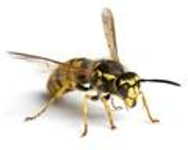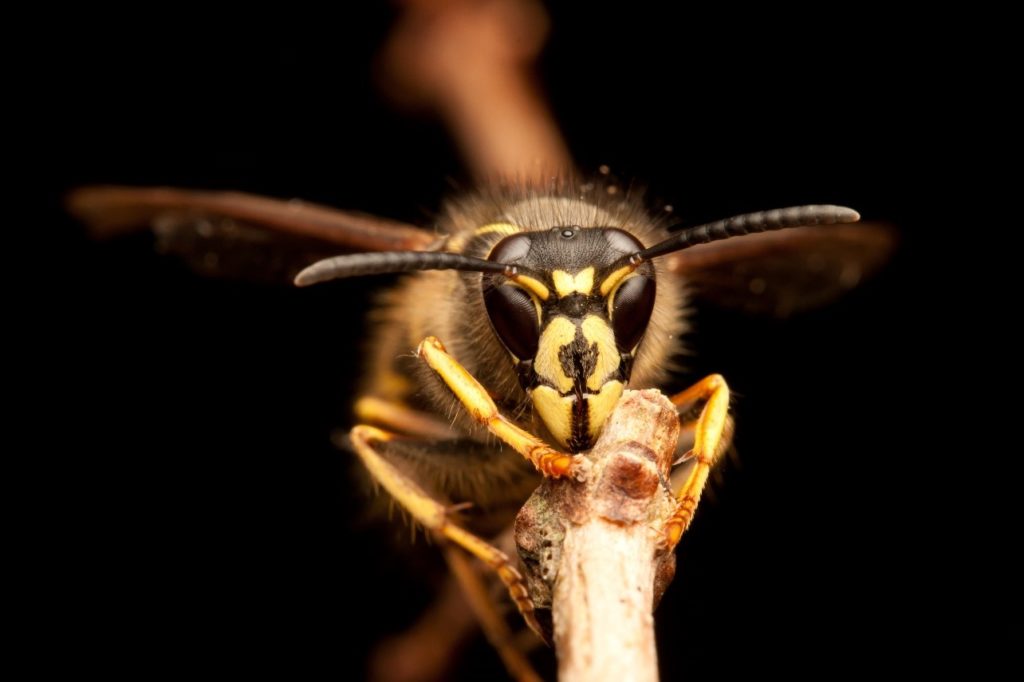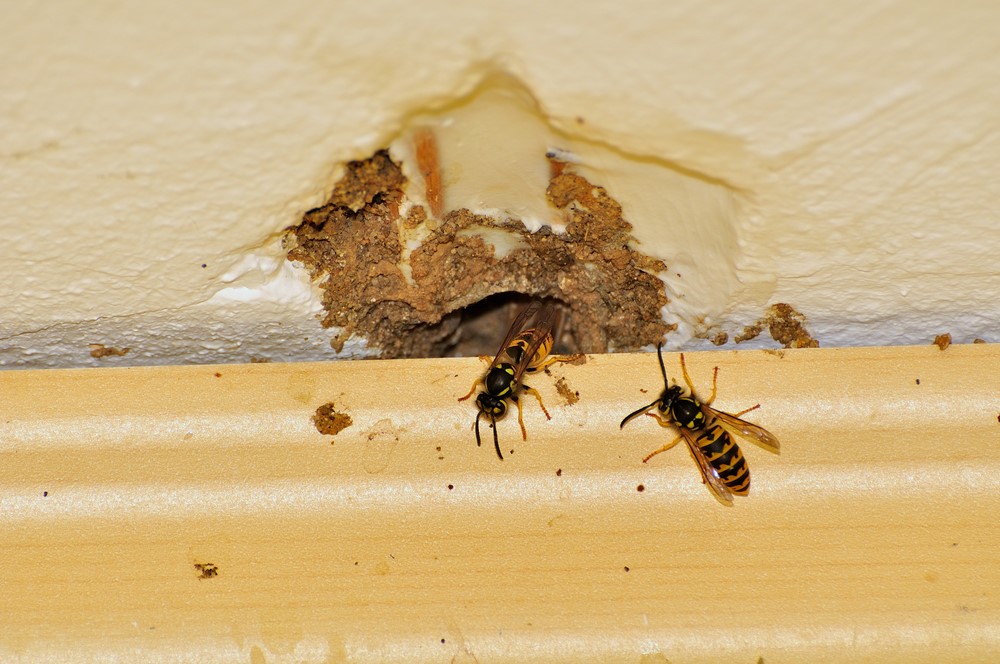
Yellow jackets are small flying pests that are native to the Central Valley and the Bay Area. They’re the smallest of the stinging pests in California, measuring less than an inch long as adults. They are aggressive and have the capability to sting multiple times when they feel threatened. Yellow jackets live in colonies of up to 5,000 in a single nest. Infestations can be especially problematic because of their nesting habits. Yellow jackets create nests in the ground that may not be found until you step on it while wearing a flip flop or run over the nest with a lawn mower. Swarms are dangerous and pose an extreme health risk for those who are allergic to bee and wasp stings. Yellow jackets can also nest within wall voids and attics if given the chance.
How can I tell if I have yellow jackets?
Yellow jackets are small stinging insects that nest in the ground, as well as between wall voids and attics of homes and businesses. The first indication that you have yellow jackets are finding the pests themselves. Yellow jackets are tiny, measuring 3/8-5/8 inch long with yellow and black coloring. Unlike wasps, yellow jackets keep their nests hidden, living in large colonies well into the thousands.
Because they usually nest in the ground, you probably won’t know that a yellow jacket colony is living on your property until you observe their movement. If you find a large number of stinging insects that are constantly traveling in and out of a single spot in the ground, you’ve most likely found a yellow jacket nest.
Yellow jackets can also nest in wall voids or attics. These protected spaces allow the colony to expand without predators. They get into human made structures by flying through broken attic vents, dryer vents, torn window screens, and other small openings. When cooler weather approaches, yellow jackets become extremely aggressive in a fight for survival. It’s especially important that you avoid yellow jackets and their nests at all costs to avoid becoming a victim.
Do yellow jackets sting?

Yes, yellow jackets can sting. They are extremely aggressive and will sting multiple times if they feel threatened. Even walking close to the nest can trigger a swarm of unforgiving, angry yellow jackets. If you try to get rid of the nest on your own or agitate it in any way, you will be swarmed by thousands of yellow jackets. Upwards of 5,000 yellow jackets can live in a single nest, so they are especially dangerous. When the cooler weather begins to move in, yellow jackets become even more aggressive. They are fighting to survive while the colony dies out.
Many people are allergic to bee stings in general, which usually includes yellow jacket stings. For these individuals, a yellow jacket sting can mean going into anaphylactic shock and a trip to the emergency room. For those who aren’t allergic, a yellow jacket sting will still cause pain and swelling.
What attracts yellow jackets to my house?
Yellow jacket nests are built within human made structures (attics, hollow walls or flooring, in sheds, under porches and eaves of houses), or in soil cavities. Nests are made from wood fiber chewed into a paper-like pulp and can house thousands of yellow jackets at any given time. Their nesting behavior can be startling if they start flying indoors with no warning. Yellow jackets have the ability to come in from outdoors, access wall voids, and fly around your house. Another unfortunate but common situation can happen if yellow jackets are nesting in the ground on your property. If you don’t notice their activity, you can easily run their nest over with a lawnmower or step directly on it with flip flops or even worse, bare feet.
Adult yellow jackets feed primarily on items rich in sugars and carbohydrates (fruits, flower nectar and tree sap), and the larvae feed on proteins (insects, meats, fish, etc.). Adult workers chew and condition the meat fed to the larvae. In late autumn, foraging workers (nuisance scavengers) change their food preference from meats to ripe, decaying fruits since larvae in the nest fail to meet requirements as a source of sugar. Sweets like open soda cans, trash cans without secure lids, and food left uncovered outdoors are buffets for yellow jackets. Scented lotion may also attract yellow jackets to humans.

How can I prevent yellow jackets from nesting on my property?
Outdoor yellow jacket prevention is difficult. Once yellow jackets have selected your yard as a nesting spot, it’s too late. However, you can take steps to prevent getting stung while you are in your backyard.
- Avoid wearing sandals or walking barefoot in the grass. Honeybees and bumblebees forage on white clover, a weed that grows in lawns throughout the country.
- Never swat at a flying insect. If need be, gently brush it aside or patiently wait for it to leave.
- Do not drink from open beverage cans outdoors. Yellow jackets will crawl inside a can attracted by the sweet beverage.
- When eating outdoors, try to keep food covered at all times.
- Garbage cans stored outside should be covered with tight-fitting lids.
- Avoid sweet-smelling perfumes, hair sprays, colognes and deodorants.
- Avoid wearing bright-colored clothing.
- Yard work and gardening should be done with caution. Wearing shoes and socks and using work gloves will prevent stings on hands and feet and provide time to get away from an unexpected mound.
To prevent yellow jackets from nesting in your home, be sure to seal up any entry points that yellow jackets can use to enter your home. Repair broken vents, holes in window screening, and fill holes up in the eaves of your home. Clean clogged gutters and to avoid potential yellow jacket breeding grounds.
How can I get rid of yellow jackets?
If you search online for “natural” or DIY yellow jacket removal strategies, you’ll probably come across the following “effective” solutions that don’t involve professional pest control services.
- Gasoline poured into the nest
- Store bought repellent sprays
- Bleach and ammonia mixture poured into the nest
- Boiling water or dish soap dumped into the nest
Not only is it extremely unsafe to treat for stinging insects on your own, but if the nest within the walls of your home, your efforts may actually be making the problem even worse, to a point where it is even difficult for pest professionals to solve the problem. If you have a nest within a wall void of your home and you decide to self-treat the yellow jackets by spraying an aerosol spray inside the entrance of the nest, you can force the yellow jackets further into your home.
AAI Pest Control does not advise that you attempt to remove a yellow jacket nest on your own in any way. You will be swarmed by yellow jackets if the nest is disturbed. It’s just not worth the risk to try DIY. Call the professionals at AAI to get rid of yellow jackets at your home.
Call us or fill out the contact form on this page for an inspection or to set up yellow jacket control services!
What Are Yellow Jackets Professional Pest Control Services in Tracy CA?
Serving Northern California
